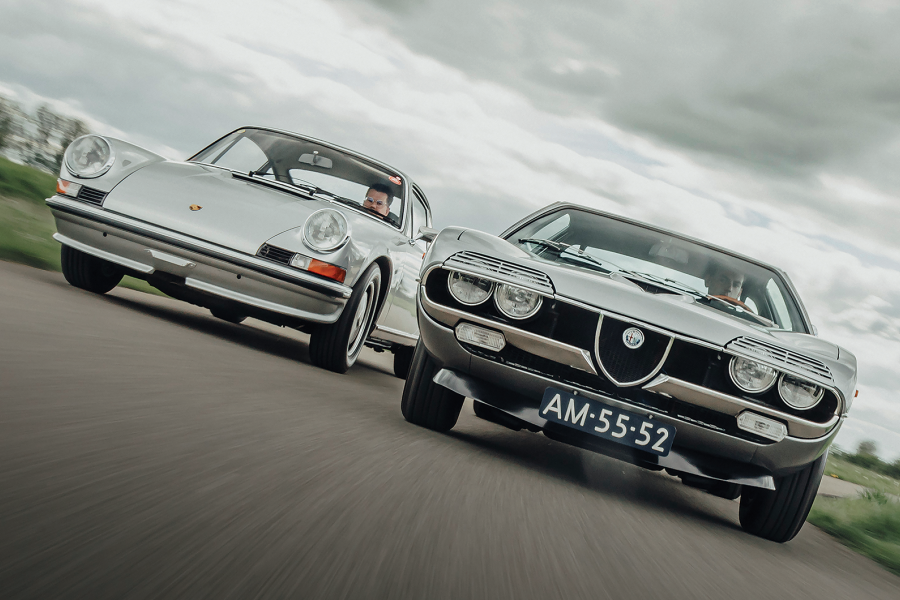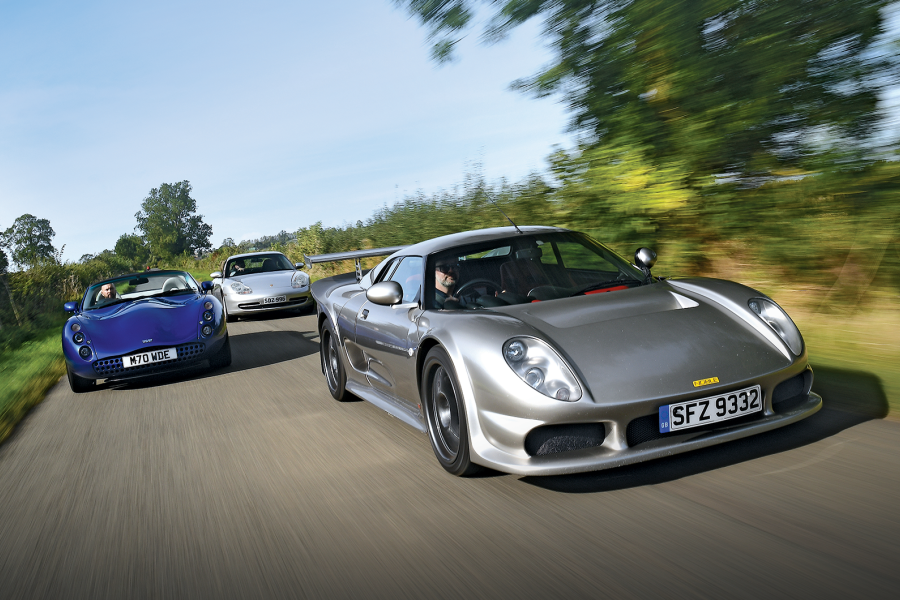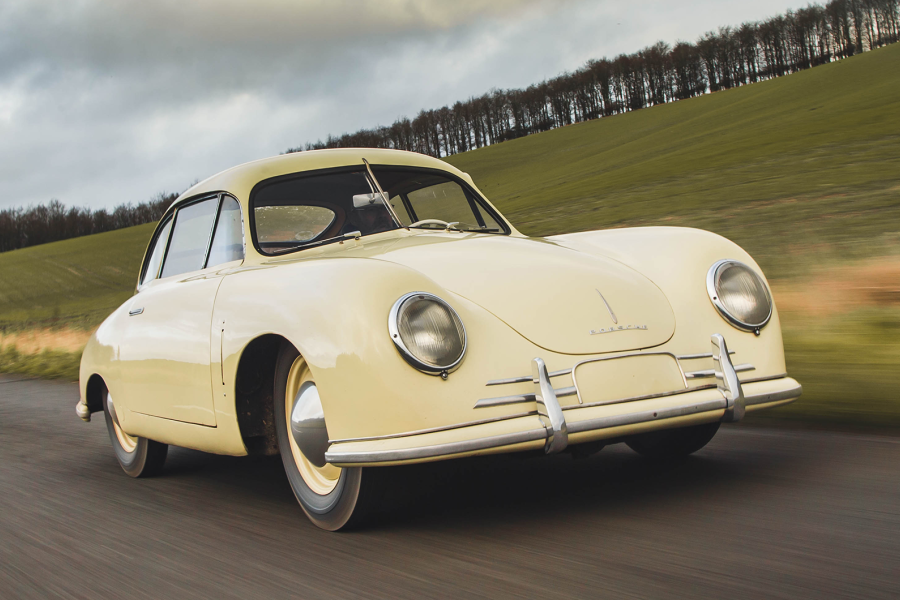Porsche needed a parts-bin special, not a technological tour de force, so it decided to apply the familiar 930 turbo recipe to its new 964-generation 911 – at that point the most significant update in the enduring model’s 26-year lifespan.
Across the 911 line-up, the basic bodyshell was fundamentally carried over, but the new, integrated bumpers made a visual break with the past, while under the skin there was coil-springing all round, plus – depending on the variant – power steering, a Tiptronic automatic transmission, ABS and all-wheel drive.
The Porsche 911 (964) turbo 3.6 is the most exciting car in this group
The 964 turbo arrived in 1991, still with rear-wheel drive, a manual gearbox and a 3.3-litre single-turbo engine, but for 1993 (the final year of production) capacity grew to 3.6 litres.
At a stroke, power was boosted from 316bhp – underwhelming given that weight increased by 170kg over the late 930 – to 355bhp.
That’s the model we have with us today, accomplished racer Ambrogio Perfetti’s beautiful right-hand-drive Aussie import, identifiable as a 3.6 by its blood-red brake calipers and 18in Speedline split-rim alloys.
Porsche 911 turbos gained an airbag-equipped steering wheel from 1991
Weight may have gone up substantially, but first impressions suggest this is the lighter car.
No doubt that’s the power-assisted steering, giving the driver much more confidence to grab the 964 by the scruff of the neck.
The new suspension set-up also feels more competent, with more immediate responses and better control, whether you are braking hard for a corner or tossing it at the apex.
Part of that proficiency is down to this car’s fresh Michelin Cup 2 rubber, with grip far beyond what the original tyres would have offered, but the 964 is still the most dynamically lively of the four Porsches here – and the only one to slide just a fraction as the boost kicks in through a third-gear kink at Bicester.
The Porsche 911 (964) turbo 3.6’s potent 355bhp flat-six and rear-drive make it entertaining on track
But offered the choice of just one of the rear-wheel-drive turbos to drive down a twisty B-road as fast as I could, this would be the pick.
Given that the 964 was the last rear-drive turbo, it’s tempting to draw parallels to the GT2 models that made this formula their own just a few years later, but the truth is that GT2s have a much more raw, feelsome character where the 964 is still very much a turbo – punchy in a straight line, entertaining through the bends, but with a level of isolation, refinement and usability lacking in those later, hardcore models.
It’s why Ambrogio uses this example for road trips, including driving it to Le Mans.
The four-wheel-drive Porsche 911 (993) turbo has sensational pace
For all the 993’s undoubtedly big steps forward, and its more mature, more luxurious interior, the final air-cooled turbo still feels very much a logical progression from the 964 – even if, this time, Porsche did manage to transfer learnings from the 959 hypercar.
The new, restyled and more aerodynamic front end suggested as much, plus under the skin there was a 20% stiffer bodyshell some 50mm wider at the hips, together with all-wheel drive and twin turbocharging.
Even basic 993 Carreras made more power than a 930 turbo, but the new 993 flagship stepped up to 402bhp – rising to 444bhp in the turbo S, a dead heat with the 959 in a package that shed 30kg versus the stock version.
The 993-generation Porsche 911 turbo benefits from a more mature cabin
Neil Clifford’s gorgeous example splits the difference between the two, being optioned both with S-spec air inlets ahead of the rear wheels and the factory X50 engine upgrade to 424bhp.
Peak power and torque were pushed up the powerband a little versus the 964, but the 993 is the more flexible unit by a margin.
Where the others wait and build, the 993 is quick from the off and then, when everything ignites, hits the fast-forward button.
Two decades on, it remains an intense experience.
Twin intercoolers on the Porsche 911 (993) turbo
The power-assisted steering is as dextrous as the 964’s, the gearchange and clutch the sweetest of the four, and even on base Carrera models the new ‘Light, Stable, Agile’ rear axle transforms the 911’s handling, giving far more control and more options when you near the rear-engined icon’s limits.
All-wheel drive builds on these foundations to brilliantly soak up the engine’s huge slug of performance, though that’s not to say you can’t use the power to manipulate the 993’s handling.
Fundamentally, the age-old Porsche 911 physics remain intact, it’s just that four-wheel drive changes the way you experience them.
From first to last: these air-cooled Porsche 911 turbos offer performance and luxury
Go a little early on the throttle with some steering lock applied and the power diverts forwards, and you feel the secure, slightly dead-feeling push of understeer, but back off the throttle, sweep that light nose at a fast apex and the 993 swings into oversteer, and lets you steer it on the throttle more readily than the purely rear-driven early cars.
The 993 is the bridge between the Porsche 911 turbo eras: a luxurious, twin-turbo, all-wheel-drive model that left its predecessor’s motorsport link at the kerb, but that air-cooled flat-six provides a common thread to the original, conceived for competition two decades before.
Images: Max Edleston
Thanks to: Sports Purpose; Bicester Heritage
Porsche 959: the 911 unleashed
The Porsche 959 was the marque’s first hypercar, and its technology trickled down to the 911 turbo
The 959 is the missing production-car link in this story, because, while it isn’t actually a 911 turbo, the innovations it pioneered soon improved the breed.
Its genesis goes back to new boss Peter Schutz joining Porsche in 1981 and reversing predecessor Ernst Fuhrmann’s plan to eventually phase out the 911.
Given that the model had been largely neglected since the mid-1970s, Schutz asked chief engineer Helmuth Bott to inject new ideas and new technology.
The Porsche 959 was built to Group B regulations
The result was the Gruppe B concept, which evolved into the production 959, Porsche’s first hypercar.
Taking the 911’s steel monocoque and an air-cooled flat-six as its base, the 959 added aluminium, polyurethane, Kevlar and carbonfibre panels to a longer, more aerodynamic body, while the adaptive suspension, all-wheel drive, sequential turbochargers and water-cooled heads worked witchcraft under the skin.
Making 444bhp and capable of 197mph, the £150,000 959 was three times costlier than a 911 turbo – and still lost money.
Factfiles
Porsche 911 (930) turbo 3.0
- Sold/number built 1974-’77/3227
- Construction steel monocoque
- Engine all-alloy, sohc-per-bank 2994cc flat-six, turbocharger and Bosch K-Jetronic fuel injection
- Max power 260bhp @ 5500rpm
- Max torque 253lb ft @ 4000rpm
- Transmission four-speed manual, RWD
- Suspension independent, at front by struts, longitudinal torsion bars rear semi-trailing arms, transverse torsion bars; telescopic dampers f/r
- Steering rack and pinion
- Brakes discs, with servo
- Length 14ft 1in (4290mm)
- Width 5ft 10in (1775mm)
- Height 4ft 3in (1320mm)
- Wheelbase 7ft 5in (2268mm)
- Weight 2635lb (1195kg)
- Mpg 22
- 0-60mph 6.1 secs
- Top speed 153mph
- Price new £14,749 (1975)
- Price now £80-375,000*
Porsche 911 (930) turbo 3.3
- Sold/number built 1978-’89/17,425
- Construction steel monocoque
- Engine all-alloy, sohc-per-bank 3299cc flat-six, turbocharger, intercooler and Bosch K-Jetronic fuel injection
- Max power 296bhp @ 5500rpm
- Max torque 304lb ft @ 4000rpm
- Transmission four/five-speed manual, RWD
- Suspension independent, at front by struts, longitudinal torsion bars rear semi-trailing arms, transverse torsion bars; telescopic dampers f/r
- Steering rack and pinion
- Brakes discs, with servo
- Length 14ft 1in (4291mm)
- Width 5ft 10in (1775mm)
- Height 4ft 3in (1310mm)
- Wheelbase 7ft 5in (2272mm)
- Weight 2866lb (1300kg)
- Mpg 18
- 0-60mph 5.3 secs
- Top speed 162mph
- Price new £27,950 (1979)
- Price now £70-350,000*
Porsche 911 (964) turbo 3.6
- Sold/number built 1991-’93/5097 (all)
- Construction steel monocoque
- Engine all-alloy, sohc-per-bank 3600cc flat-six, turbocharger, intercooler and Bosch K-Jetronic fuel injection
- Max power 355bhp @ 5500rpm
- Max torque 384lb ft @ 4200rpm
- Transmission five-speed manual, RWD via LSD
- Suspension independent, at front by MacPherson struts rear semi-trailing arms, coil springs, telescopic dampers; anti-roll bar f/r
- Steering power-assisted rack and pinion
- Brakes discs, with servo and ABS
- Length 14ft ¼in (4275mm)
- Width 5ft 10in (1775mm)
- Height 4ft 3in (1308mm)
- Wheelbase 7ft 5in (2272mm)
- Weight 3241lb (1470kg)
- Mpg 21
- 0-60mph 4.7 secs
- Top speed 174mph
- Price new £72,294 (1992)
- Price now £70-325,000*
Porsche 911 (993) turbo
- Sold/number built 1995-’98/5978
- Construction steel monocoque
- Engine all-alloy, sohc-per-bank 3600cc flat-six, twin turbochargers, twin intercoolers and Bosch DME sequential fuel injection
- Max power 402bhp @ 5750rpm
- Max torque 398lb ft @ 4500rpm
- Transmission six-speed manual, 4WD
- Suspension independent, at front by MacPherson struts rear multi-link, coil springs, telescopic dampers; anti-roll bar f/r
- Steering power-assisted rack and pinion
- Brakes discs, with servo and ABS
- Length 13ft 11in (4245mm)
- Width 5ft 11in (1795mm)
- Height 4ft 3in (1285mm)
- Wheelbase 7ft 5in (2272mm)
- Weight 3307lb (1500kg)
- Mpg 18
- 0-60mph 4.3 secs
- Top speed 180mph
- Price new £97,950 (1996)
- Price now £100-235,000*
*Prices correct at date of original publication
Enjoy more of the world’s best classic car content every month when you subscribe to C&SC – get our latest deals here
READ MORE
’80s supercar shootout: Lamborghini Countach vs Porsche 911 turbo vs Ferrari Testarossa
Wild bunch: Saab 99 vs Porsche 911 vs BMW 2002
Buyer’s guide: Porsche 911 (1974-’89)
Ben Barry
Ben Barry is a contributor to Classic & Sports Car




























